
Dar Bou Hachem is a palace in the medina of Tunis.

Dar Bou Hachem is a palace in the medina of Tunis.

This palace is situated in a dead end named "Bou Hachem", which is deriving from the street where it is located.
The owners of this palace came to Tunis under the Hafsid dynasty's reign.

Tunis is the capital and the largest city of Tunisia. The greater metropolitan area of Tunis, often referred to as Grand Tunis, has some 2,700,000 inhabitants.

The Hafsids were a Sunni Muslim dynasty of Berber descent who ruled Ifriqiya from 1229 to 1574.
They lived in this house during the 19th and the early 20th century. [1]

The 19th (nineteenth) century was a century that began on January 1, 1801, and ended on December 31, 1900. It is often used interchangeably with the 1800s, though the start and end dates differ by a year.

The 20th (twentieth) century was a century that began on January 1, 1901 and ended on December 31, 2000. It was the tenth and final century of the 2nd millennium. It is distinct from the century known as the 1900s which began on January 1, 1900 and ended on December 31, 1999.
The access to this palace is defended by a solid closed door. It is a narrow passage, covered at its beginning by a series of five vaults. [1]

In architecture, a vault is a self-supporting arched form, usually of stone or brick, serving to cover a space with a ceiling or roof. The simplest kind of vault is the barrel vault, which is generally semicircular in shape. The barrel vault is a continuous arch, the length being greater than its diameter. As in building an arch, a temporary support is needed while rings of voussoirs are constructed and the rings placed in position. Until the topmost voussoir, the keystone, is positioned, the vault is not self-supporting. Where timber is easily obtained, this temporary support is provided by centering consisting of a framed truss with a semicircular or segmental head, which supports the voussoirs until the ring of the whole arch is completed. With a barrel vault, the centering can then be shifted on to support the next rings.
The doors of the makhzen lead to a covered walkway.
The raised patio is surrounded by richly decorated apartments decorated with earthenware, stucco and marble. [1]

A patio is an outdoor space generally used for dining or recreation that adjoins a residence and is typically paved. In Australia the term is expanded to include roofed structures similar to a pergola, which provides protection from sun and rain.

Earthenware is glazed or unglazed nonvitreous pottery that has normally been fired below 1200 °C. Porcelain, bone china, and stoneware, all fired at high enough temperatures to vitrify, are the main other important types of pottery.

Stucco or render is a construction material made of aggregates, a binder, and water. Stucco is applied wet and hardens to a very dense solid. It is used as a decorative coating for walls and ceilings, and as a sculptural and artistic material in architecture. Stucco may be used to cover less visually appealing construction materials, such as metal, concrete, cinder block, or clay brick and adobe.

Mascara is a province (wilaya) in Algeria. It was named after its capital, whose name is Arabic for "military garrison", and which is unrelated to "mascara", the cosmetic. Another important locality is the town of Sig.

Sidi Bou Said is a town in northern Tunisia located about 20 km from the capital, Tunis.
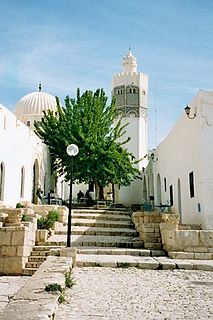
El Kef, also known as Le Kef, is a city in northwestern Tunisia. It serves as the capital of the Kef Governorate.
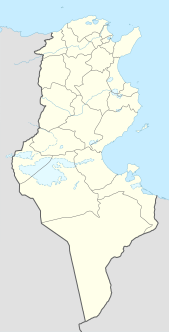
Bou Grara Airfield is an abandoned World War II military airfield in Tunisia, which was located near Golfe de Bou Grara (Madanin); about 360 km south-southeast of Tunis.

Ksar Mosque or Jemaâ Al Ksar, also of the Hanafi rite, is a mosque in Tunis, Tunisia.
Madrasa Slimania is a former madrasa and one of the monuments of the Ottoman era in the medina of Tunis.

Madrasa Ennakhla ou Madrasa of the Palm is a former madrasa and one of the monuments of the Ottoman era in the medina of Tunis. It is named after the palm tree at the center of its patio which still stands today.
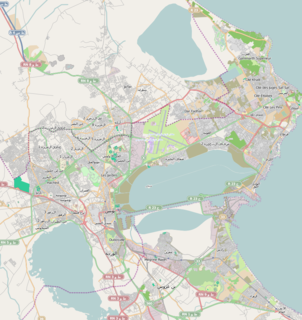
Carthage is a commune in Tunis Governorate, Tunisia. It is named for, and includes in its area, the archaeological site of Carthage.
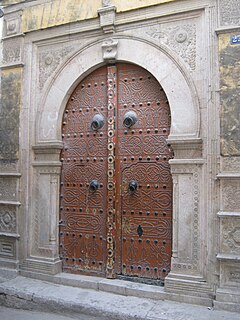
Dar Balma is an old palace in the medina of Tunis.

Dar Al Jaziri is a palace in the medina of Tunis. Located in the Tribunal Street, a few meters from Dar Lasram, it was one of the residences of the Jaziri family between the 12th and 18th centuries.
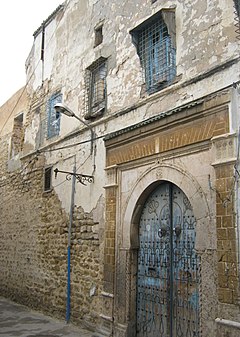
Dar Ibn Abi Dhiaf is a palace in the medina of Tunis, located near the Pasha Street and Sidi Mahrez Mosque, in the Ibn Abi Diaf dead end.

Dar Bach Hamba is an old palace in the medina of Tunis.

Dar Othman is one of the palaces of the medina of Tunis. The residence is located in the south of the medina, 16 El Mebazaâ Street.

Dar Djaït is an old palace of the Medina of Tunis. It is located in the Street of Sidi ben Arous.

Dar El Bey, also known as the government palace is an old palace in the medina of Tunis, more precisely in the city's Kasbah. Nowadays, it serves as the office of the Head of Government of Tunisia but was used by guests of the State previously. It is located south of Government Square, west of Kasbah Square.

Saheb Ettabaâ Palace is an old palace in the Medina of Tunis.
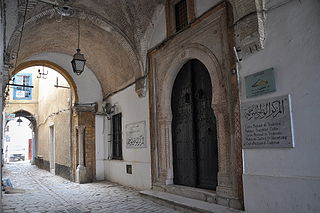
Dar El Monastiri is a palace in the Medina of Tunis.

The R'cif Mosque is a Friday mosque in Fes el-Bali, the old city (medina) of Fez, Morocco. It has one of the tallest minarets in the city and overlooks Place R'cif in the heart of the medina.
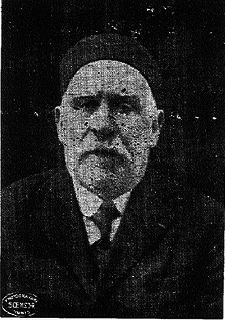
Jacob Chemla was a Tunisian Jewish ceramic artist, as well as an author, journalist and translator in Judeo-Tunisian Arabic.